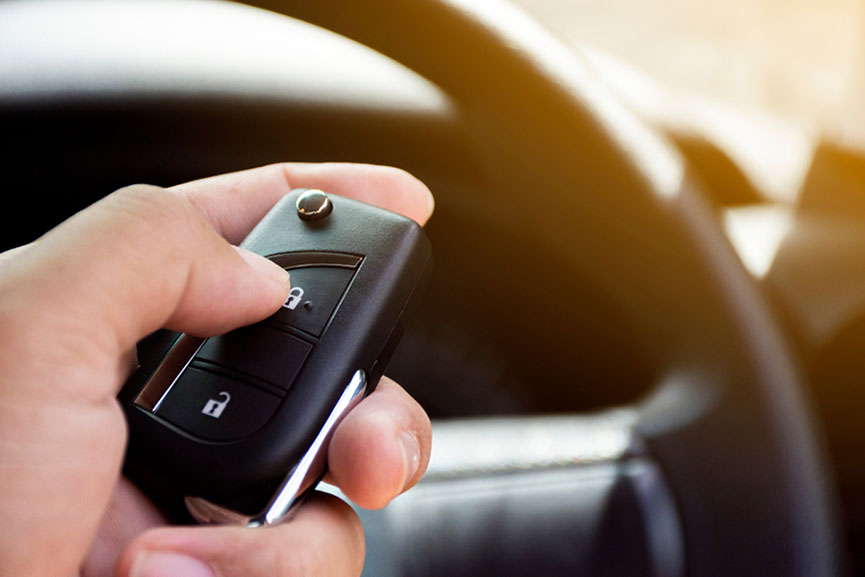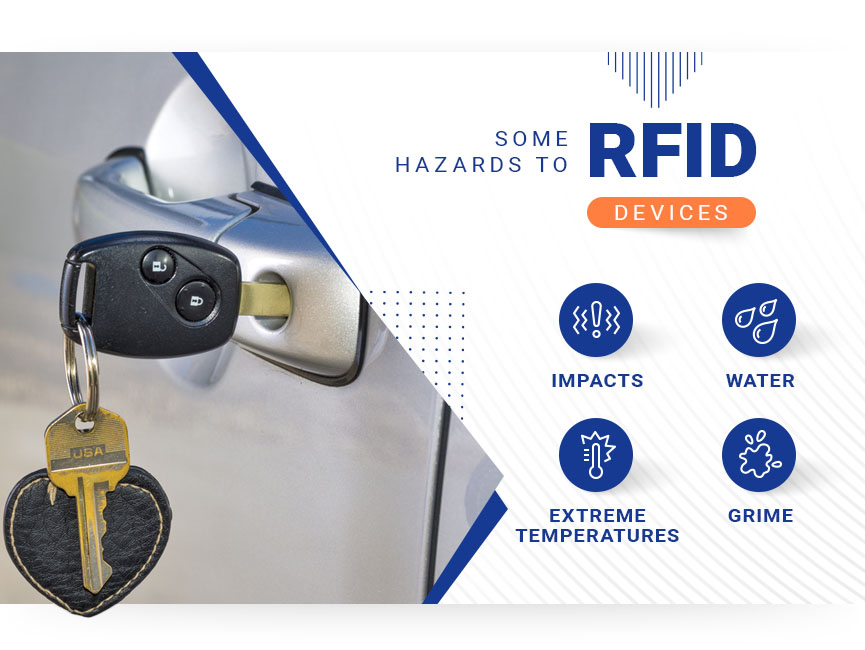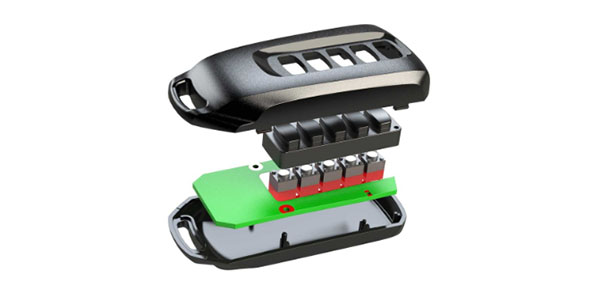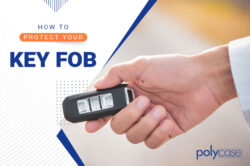
Fifty years ago, if you asked someone “what is a key fob?” they’d probably show you their favorite keychain. (Believe it or not, that was the original meaning of the term!) Today, however, key fobs do a lot more. They function as tiny remote controls that offer secure access to our vehicles, offices or even our homes. That’s why it’s so important to take basic precautions to avoid having your key fob damaged or compromised.
What are the major dos and don’ts that everyone should be aware of when using or designing a key fob device? How do these precautions address common concerns about the use of key fobs? This guide will bring you up to speed on how to protect your key fob, why it’s important and how Polycase’s key fob enclosures provide a durable and high quality key fob solution.
Why Do Key Fobs Need Protection?
Unfortunately, key fobs, like all electronic devices, aren’t foolproof and can be damaged or misused. The most prominent example is one you might have heard about: a technique called a relay attack that allows bad actors to capture the RFID signals from key fobs. When this technique works, it can open the door for all kinds of negative consequences, including people’s cars being stolen right out of their driveways.
Key fobs used for other applications, such as security badges for building access, are also potentially vulnerable to interception and relay attacks. In some cases, an attacker might even use a blank key fob onto which they can “clone” the original, giving them permanent access without the key fob’s owner even being aware. It’s easy to see how this can open the door (literally) to a wide variety of security threats.
Security isn’t the only reason to make sure your key fob is protected. Key fobs are also vulnerable to hazards from their physical environments, such as impacts, contact with liquids or extreme heat. Mitigating these risks is an important part of the key fob design process, but it’s equally crucial for everyday fob users to take some common sense precautions for protecting their devices. We’ll talk more about physical hazards to your key fob later in this article.
Understanding the Threat of Key Fob Hacking

To protect your key fob from being hacked, it’s helpful to first understand how the most common key fob interception attacks work. Here’s the basic idea, using the theft of a push-to-start vehicle from a person’s driveway as an example:
- RFID relay attackers usually work in pairs — one person next to the vehicle, one next to the building. Each carries a relay device that transmits and amplifies RF signals.
- The attacker near the car uses their device to pick up the RF signal that the car uses to look for the key fob’s presence.
- Meanwhile, the attacker near the house uses their device to pick up RF signals from any key fobs that might be nearby, such as one hanging next to the front door.
- The thieves create a signal chain between the car, the first RF device, the second RF device and the key fob inside the house.
- The lock “thinks” it’s actually communicating with the key fob and allows the attackers to open the vehicle. Once they’re inside, they can typically use the same process to start the car’s ignition.
- The thieves drive off with the car, which continues to run even without the key fob.
This method isn’t the only way to perform an RFID attack, nor are vehicle thefts the only application of these techniques. As previously mentioned, RFID security badges are also susceptible, and even the RFID chips in passports and credit cards have been reported as potential targets. Although these other types of attacks aren’t yet widespread, it’s reasonable to expect that they could increase as tap-to-pay cards and smart passports become more common.
What Is a Faraday Cage?
Faraday cages are a tried-and-true solution that offer one of the most dependable ways to block RFID interception attacks. Let’s take a quick look at how they work and why people use them to protect their key fobs.

Conductive metals, such as aluminum and steel, are highly effective at blocking electromagnetic signals such as radio waves. Thus, surrounding a key fob with these conductive metals can be a practical method for protecting the fob from RFID attacks. (This is also why aluminum enclosures can help protect your electronic devices from electromagnetic interference.)
So, why not build a Faraday cage into a key fob? Unfortunately, this would block the RF signals that make the fob work in the first place. However, several other options exist for securing your fob using a Faraday cage.
How Can I Use a Faraday Cage to Protect My Key Fob?
“Faraday pouches” are the most popular way to protect key fobs from RFID attacks. These cloth pouches are lined with a layer of metal, usually aluminum, that acts as a Faraday cage and attenuates the RF signals that the fob sends and receives. When your key fob or ID badge isn’t in use, place it in the pouch and then simply retrieve it again as necessary.
Note that the efficacy of this method depends on purchasing a Faraday pouch that’s up to the job and using it correctly. It’s advisable to spend a little more on a pouch with good reviews and detailed specs. For those who have RFID-based cards in their wallets, RFID wallets are also a popular option.
Once you have your pouch, read the directions carefully to ensure that you understand how to use it. Learn about some of the methods for testing RFID blocker performance using cell phones or wireless locator tags, and try running a quick test yourself before you trust your most important devices to a new Faraday pouch or wallet.
Some people create makeshift Faraday cages for their fobs. The methods used can include wrapping the fob in aluminum foil or placing it inside a metallic container such as a safe or refrigerator. However, these methods can be unreliable, or even harmful if (for example) you damage the fob through exposure to extreme temperatures.

Other Techniques for Securing Key Fobs
Other techniques exist that can help you secure your key fob or RFID badge. These can work in combination with a Faraday pouch, or you might employ one or more of them as a substitute if a pouch isn’t an option:
- Many automakers now equip their key fobs with “sleep” modes that turn RF signals off when the fob hasn’t moved in a certain period of time. Check the documentation associated with your key fob system to learn about whether it includes a sleep mode and how the feature works.
- Some RFID systems also include the option to turn off remote keyless entry completely. While this will mean temporarily sacrificing the convenience of your remote keyless system, it can be a good move if (for example) you know that RFID thieves have been active in your area recently.
- Avoid keeping your keys hanging by the door or anywhere else close to an exterior wall or entry point. The closer your key fob is to the outside of your home, the easier it is to intercept and redirect its signals.
- Park your vehicle in a secure location such as a garage or closed driveway. Making it harder for attackers to get close to your RFID devices makes it less likely that you’ll be a target.
- Add additional physical security layers that an intruder will have to navigate even if they succeed with an RFID attack. These might include a number combination lock for a building, a locking enclosure for an electrical device or security system or a steering wheel lock for a vehicle.
Unattended Vehicle Hazards
Keyless entry systems on vehicles can also present major hazards if the vehicle operator forgets to turn off the engine or put the vehicle in Park. A mechanical key is usually impossible to remove from the ignition unless the engine is off and in Park, but there’s no such safeguard with most proximity keys, and removing them from the vehicle often does not actually stop the engine.
If you’re lucky, this will only drain your vehicle’s battery (annoying in itself). If the engine is left on in an attached garage, on the other hand, it can create a potentially lethal carbon monoxide hazard. Rollaway crashes, in which the vehicle rolls away after the driver neglects to engage Park mode, are another dangerous consequence of unfamiliarity with remote keyless systems.
Anyone who uses a keyless entry system on a vehicle or other heavy equipment should be aware of these dangers. The good news is that some new vehicles now include automated systems that turn the engine off after a certain period of idle time, and some U.S. legislators have called for new safety laws to regulate keyless cars. Ultimately, the solution will require both an evolution of auto industry standards and a commitment from drivers to get in the habit of checking that the engine is off and the vehicle is in Park.

Other Hazards to RFID Devices
Damage to a key fob or security badge is also an important concern for the many people who rely on these RFID devices. The good news is that the internal components of most RFID devices are durable enough to withstand minor everyday bumps and temperature fluctuation. However, that doesn’t mean they’re indestructible.
These are some of the major hazards that key fob users and manufacturers should be aware of:
- Impacts: Drops, bumps and other impacts can move or deform the internal components inside the key fob enclosure.
- Water and Other Liquids: Most key fobs are not designed to be liquid-proof, so avoid exposing your fob to wet weather conditions, submersion or other liquids such as oils.
- Extreme Temperatures: Exposure to extremely high or low temperatures can have negative effects on the device’s components.
- Dirt and Grime: Some key fobs can easily accumulate debris, which can cause malfunctions if it blocks contact points or prevents buttons from pressing completely.
Preventing Damage to RFID Devices
First, it’s important that the manufacturers who create key fobs choose suitable key fob cases to protect their devices. Look for a fob cover made from a durable plastic material such as ABS plastic, which will improve its resilience to shocks and drops. In addition, it can be advantageous to use a snap-fit case, since many of these are designed to hold a circuit board securely in place.
These are some other precautions that everyday RFID device users can take to protect their fobs:
- When possible, avoid keeping your key fob in your pocket or bag for extended periods, where it can get bumped around and attract lint and dirt.
- Don’t leave your key fob in your vehicle. In addition to being a security risk, this can expose the fob to excessively hot or cold temperatures.
- Avoid exposing your key fob to situations where it might be splashed with (or submerged in) water or any other liquid.
- Don’t store a key fob close to your vehicle. In addition to increasing your vulnerability to hacking, it will often drain the fob’s battery more quickly since it will constantly try to communicate with the vehicle.

Polycase FB-45 key fob enclosure, shown with mounted circuit board and optional buttons.
Handheld Key Fob Enclosures and More
Polycase is your one-stop source for handheld electronics enclosures, including key fob enclosures and so much more. If you’re wondering which handheld enclosure is right for your application, we’ve got lots of resources to help you choose!
First, check out some of the many other articles on our TechTalk Blog with important info. Our guide to key fobs answers basic questions about how key fobs work and our primer on electrical interference will get you up to speed on important concepts like RF shielding.
Ready to choose an enclosure for your key fob or other handheld electronic device? Polycase has an industry-leading selection of handheld electronics enclosures to choose from. Our FB Series are sturdy ABS plastic enclosures designed specifically for use as key fobs, complete with options for adding built-in buttons and battery holders. As always, remember that we offer the industry’s fastest and most convenient enclosure customization, including custom CNC machining and digital printing, to give you the exact enclosure you need at the right price.
Image Credits
HeyDessein/Shutterstock.com
Sawat Banyenngam/Shutterstock.com
Buntoon Rodseng/Shutterstock.com
Happy Stock Photo/Shutterstock.com
Klepach/Shutterstock.com
Charles Knowles/Shutterstock.com
davooda/Shutterstock.com
BLKstudio/Shutterstock.com
